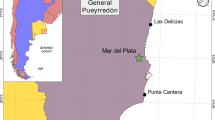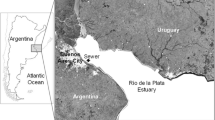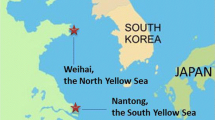Abstract
Polychlorinated biphenyls (PCBs) and DDTs (p,p′-DDE +p,p′-DDT) were quantitated in four species of antarctic fish collected around the Japanese Antarctic Research Station during January to December 1981. PCBs ranged between 0.08 and 0.77 ng/g and DDTs from 0.3 to 1.9 ng/g, wet weight basis in whole body homogenates. InPagothenia borchgrevinki, the largest sample (N=21), both classes of chlorinated hydrocarbons increased linearly with body weight. Analysis of PCB isomers and congeners by mass fragmentography showed greater retention of the more highly chlorinated biphenyls in larger specimens. The bottom dwellingTrematomus bernacchii andT. hansoni revealed greater concentrations of highly chlorinated biphenyls than the surface dwellingP. borchgrevinki. In general, the concentrations of PCBs and DDTs in antarctic fish were very low compared to other open ocean water fish reported in the literature; this agreed with atmospheric and hydrospheric concentrations of PCBs and DDTs in antarctic regions where low levels were reported.
Similar content being viewed by others
References
Atlas, E., and C. S. Giam: Global transport of organic pollutants: Ambient concentrations in the remote marine atmosphere. Science211, 163 (1981).
Bidleman, T. F., E. J. Christensen, W. M. Billings, and R. Leonard: Atmospheric transport of organochlorines in the North Atlantic Gyre. J. Mar. Res.39, 443 (1981).
Bruggeman, W. A., L. B. J. M. Martron, D. Kooiman, and O. Hutzinger: Accumulation and elimination kinetics of di-, tri-, and tetra chlorobiphenyls by goldfish after dietary and aqueous exposure. Chemosphere10, 811 (1981).
Frank, R., A. E. Armstrong, R. G. Boelens, H. E. Braun, and C. W. Douglas: Organochlorine insecticide residues in sediment and fish tissues, Ontario, Canada. Pest. Monit. J.7, 165 (1974).
George, J. L., and D. E. H. Frear: Pesticides in the antarctic. J. Appl. Ecol.3 (Supplement 3), 155 (1966).
Giam, C. S., R. L. Richardson, M. K. Wong, and W. M. Sackett: Polychlorinated biphenyls in antarctic biota. Antarctic J.8, 303 (1973).
Harvey, G. R., H. P. Miklas, V. T. Bowen, and W. G. Steinhauer: Observations on the distribution of chlorinated hydrocarbons in Atlantic Ocean organisms. J. Mar. Res.32, 103 (1974).
Hattula, M. L., J. Janatuinen, J. Sarkka, and J. Passivirta: A five year monitoring study of the chlorinated hydrocarbons in the fish of a Finnish lake ecosystem. Environ. Pollut.15, 121 (1978).
Jensen, S., A. G. Johnels, M. Olsson, and G. Otterlind: DDT and PCB in herring and cod from the Baltic, the kattegat, and the skagerrak. Ambio Special Report1, 71 (1972).
Murayama, H., S. Soma, A. Iida, and M. Takagi: PCB contents in several fish obtained in the Okhotsk Sea and the Bering Sea. (in Japanese). Proceedings of Hakodate Junior College17, 1 (1974).
Murphy, P. G.: The effect of size on the uptake of DDT from water by fish. Bull. Environ. Contam. Toxicol.6, 20 (1971).
Peel, D. A.: Organochlorine residues in antarctic snow. Nature254, 324 (1975).
Risebrough, R. W., and G. M. Carmignani: Chlorinated hydrocarbons in antarctic birds. In B. C. Parker (ed.): Proceedings of the Colloquium, conservation problems in Antarctica. Lawrence, KS: Allen Press, (1972).
Risebrough, R. W., W. Walker II, T. T. Schmidt, B. W. de Lappe, and C. W. Connors: Transfer of chlorinated biphenyls to antarctica. Nature264, 738 (1976).
Sladen, W. J. L., C. M. Menzie, and W. L. Reichel: DDT residues in Adélie penguins and a crabeater seal from Antarctica. Nature210, 670 (1966).
Takagi, M., H. Murayama, and S. Soma: PCB contents in several species of flatfish collected in the Eastern Bering Sea. (in Japanese). Bull. Jap. Soc. Sci. Fish.41, 685 (1975).
Tanabe, S., H. Tanaka, R. Tatsukawa, and I. Nakamura: Organochlorine compound residues in several species of fishes caught off Chile, (in Japanese). Bull. Jap. Soc. Sci. Fish.46, 763 (1980).
Tanabe, S., Y. Nakagawa, and R. Tatsukawa: Absorption efficiency and biological half-life of individual chlorobiphenyls in rats treated with Kanechlor® products. Agric. Biol. Chem.45, 717 (1981).
Tanabe, S., M. Kawano, and R. Tatsukawa: Chlorinated hydrocarbons in the Antarctic, Western Pacific and Eastern Indian Oceans. Trans. Tokyo Univ. Fish. No. 5, 97 (1982a).
Tanabe, S., R. Tatsukawa, M. Kawano, and H. Hidaka: Global distribution and atmospheric transport of chlorinated hydrocarbons: HCH (BHC) isomers and DDT compounds in the Western Pacific, Eastern Indian, and Antarctic Oceans. J. Oceanogr. Soc. Japan38, 137 (1982b).
Tanabe, S., H. Hidaka, and R. Tatsukawa: PCBs and chlorinated hydrocarbon pesticides in Antarctic atmosphere and hydrosphere. Chemosphere12, 277 (1983).
Tanaka, H.: Bioaccumulation of chlorinated hydrocarbons in open ocean ecosystems. Master's thesis, Ehime University, Japan (1982).
Tatsukawa, R., S. Tanabe, and T. Yoshida: KaiyŌkankyŌ chŌ- sahŌ (in Japanese). The Oceanogr. Soc. Japan. KŌseisha Koseikaku, Tokyo 232 (1979).
Wakimoto, T., R. Tatsukawa, and T. Ogawa: Analytical method of PCBs (in Japanese). J. Environ. Pollut. Control7, 517 (1971).
Walker II, W., R. W. Risebrough, and G. W. Bowes: South American studies of the peregrine, an indicator species for persistent pollutants. Antarctic J.8, 29 (1973).
Author information
Authors and Affiliations
Rights and permissions
About this article
Cite this article
Subramanian, B.R., Tanabe, S., Hidaka, H. et al. DDTs and PCB isomers and congeners in antarctic fish. Arch. Environ. Contam. Toxicol. 12, 621–626 (1983). https://doi.org/10.1007/BF01060743
Received:
Revised:
Issue Date:
DOI: https://doi.org/10.1007/BF01060743




